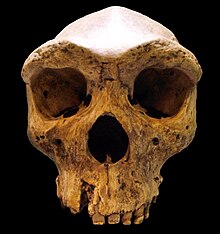
−10 — – −9 — – −8 — – −7 — – −6 — – −5 — – −4 — – −3 — – −2 — – −1 — – 0 — |
| |||||||||||||||||||||||||||||
Archaic humans is a broad category denoting all species of the genus Homo that are not Homo sapiens (which are known as modern humans). Among the earliest modern human remains are those from Jebel Irhoud in Morocco (about 315 ka), Florisbad in South Africa (259 ka), and Omo-Kibish I (Omo I) in southern Ethiopia (c. 233 or 195 ka). Some examples of archaic humans include H. antecessor (1200–770 ka), H. bodoensis (1200–300 ka), H. heidelbergensis (600–200 ka), Neanderthals (H. neanderthalensis; 430–40 ka), H. rhodesiensis (300–125 ka) and Denisovans (H. denisova; 285–52 ka),
Most archaic humans had a brain size averaging 1,200 to 1,400 cubic centimeters, which overlaps with the range of modern humans. Notable exceptions include Homo naledi and Homo floresiensis, having cranial capacities of 465-610 and 380 cubic centimeters, respectively.
Archaic humans are distinguished from anatomically modern humans by having a thick skull, prominent supraorbital ridges (brow ridges) and the lack of a prominent chin.
Anatomically modern humans appeared around 300,000 years ago in Africa, and 70,000 years ago gradually supplanted the "archaic" human varieties. Non-modern varieties of Homo are certain to have survived until after 30,000 years ago, and perhaps until as recently as 12,000 years ago. According to recent genetic studies, modern humans may have bred with two or more groups of archaic humans, including Neanderthals and Denisovans. Other studies have cast doubt on admixture being the source of the shared genetic markers between archaic and modern humans, pointing to an ancestral origin of the traits which originated 500,000–800,000 years ago. In August 2023, scientists reported the discovery of an unknown ancient human hominin that may have lived 300,000 years ago in China.
Terminology and definition
The category archaic human lacks a single, agreed definition. According to one definition, Homo sapiens is a single species comprising several subspecies that include the archaics and modern humans. Under this definition, modern humans are referred to as Homo sapiens sapiens and archaics are also designated with the prefix "Homo sapiens". For example, the Neanderthals are Homo sapiens neanderthalensis, and Homo heidelbergensis is Homo sapiens heidelbergensis. Other taxonomists prefer not to consider archaics and modern humans as a single species but as several different species. In this case the standard taxonomy is used, i.e. Homo rhodesiensis, or Homo neanderthalensis.
The evolutionary dividing lines that separate modern humans from archaic humans and archaic humans from Homo erectus are unclear. The earliest known fossils of anatomically modern humans such as the Omo remains from 233,000-195,000 years ago, Homo sapiens idaltu from 160,000 years ago, and Qafzeh remains from 90,000 years ago are recognizably modern humans. These early modern humans possess a number of archaic traits, such as moderate, but not prominent, brow ridges.
Brain size expansion

The emergence of archaic humans is sometimes used as an example of punctuated equilibrium. This occurs when a species undergoes significant biological evolution within a relatively short period. Subsequently, the species undergoes very little change for long periods until the next punctuation. The brain size of archaic humans expanded significantly from 900 cm3 (55 cu in) in erectus to 1,300 cm3 (79 cu in). Since the peak of human brain size during the archaics, it has begun to decline.
Origin of language
Robin Dunbar has argued that archaic humans were the first to use language. Based on his analysis of the relationship between brain size and hominin group size, he concluded that because archaic humans had large brains, they must have lived in groups of over 120 individuals. Dunbar argues that it was not possible for hominins to live in such large groups without using language, otherwise there could be no group cohesion and the group would disintegrate. By comparison, chimpanzees live in smaller groups of up to 50 individuals.
